Uncategorized
Quantifying The Need: A Survey Of Existing Sound Recordings In Collections In The United States
2 January 2014
In 2014, AVP and the Northeast Document Conservation Center (NEDCC), with funding from The Andrew W. Mellon Foundation, undertook an in-depth, multi-faceted assessment to quantify the existing audio items held in institutional collections throughout the United States. This was performed in response to The Library of Congress National Recording Preservation Plan and its call for the appraisal of collections, as well as to establish a foundation for articulating the current preservation need of sound recordings in collections nationwide.
Our goal was to acquire enough trustworthy data to be able to answer questions such as “How many sound recordings exist in broadcast organizations across the US?” or “How many sound recordings exist in archives throughout the US?” Moreover, we wanted to answer more complex questions such as “How many of such items are preservation-worthy?” or “How many have already been digitized?” Prioritization for digitization is as critical as both funding and timeliness. The foundation for action on all three of these fronts is trustworthy quantitative data. This paper aims to provide such data along with supporting information about the methodologies used in its generation.
Smithsonian Digital Preservation Readiness Assessment
1 January 2014
In July 2009, Smithsonian Secretary G. Wayne Clough spoke of the digital future of museums, libraries, and archives. “We have the capacity to tell the story of America and all its hopes, struggles, triumphs, creativity, contradictions, and courage.” “Ultimately, we want to put all of our … objects … online so you can access them wherever you live. We want to offer the Smithsonian experience to everyone,” said Clough to a group gathered at the National Press Club in Washington, D.C.
To ensure the longevity of these born-digital and digitized collections, research, and resources, in 2014 Secretary Clough chartered a Digital Preservation Working Group to assess current preservation practices and develop lifecycle management recommendations for the future.
AVP Holiday Card – 2013
31 December 2013
Artwork by Stephanie Housley from Coral & Tusk (printed card and laser-cut audiocassette)
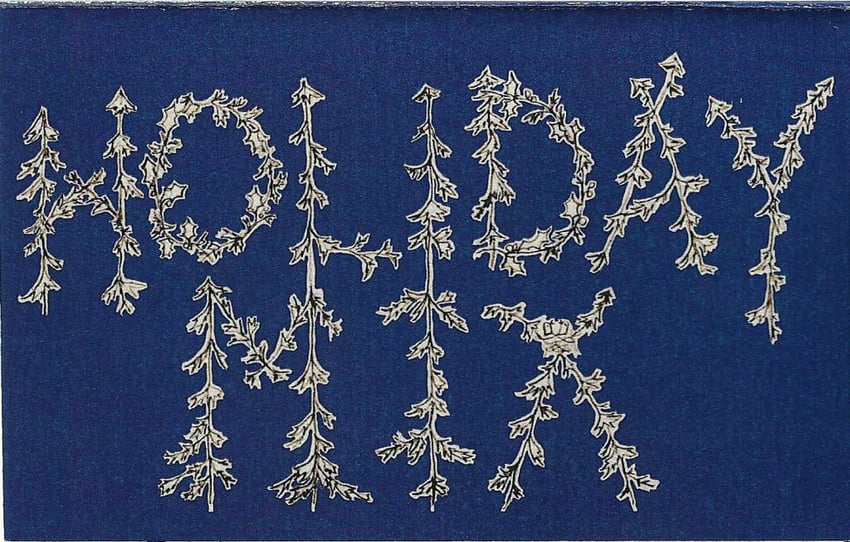

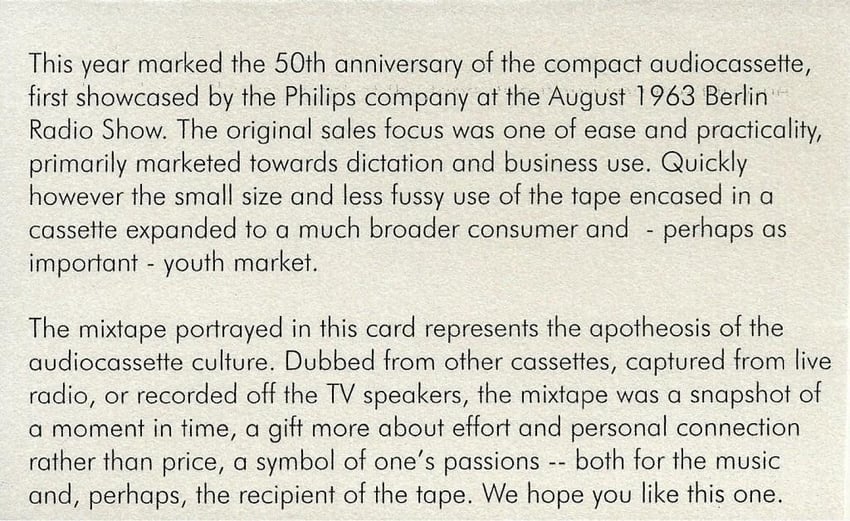
All Images on this page are copyright protected and may not be reproduced or used without permission from AudioVisual Preservation Solutions.
More Podcast, Less Process Holiday Edition
23 December 2013
Episode 5 (née 4.5) of More Podcast, Less Process, the archives podcast, has been released. “Year End Wrap Up — The Archivist Says…” is a special holiday edition of the podcast, collecting brief interviews with real live archivists recorded at the 2013 New York Archivists Round Table Awards Ceremony and the 2013 Association of Moving Image Archivists annual conference. Josh (and guest interviewer Seth Anderson) go on location with hard hitting questions such as “What is your name?” and “What’s the most awesomest thing in your collection?” Enjoy the pre-holiday cheer as part of your holidays, but enjoy responsibly.
As always, you can listen through iTunes, Soundcloud, and Internet Archive; find information and direct downloads on the More Podcast, Less Process page at keepingcollections. org, or follow our RSS feed at http://morepodcast.libsyn.com/rss.
AVPreserve Releases New Metadata Web Tutorial
3 December 2013
In the digital realm, metadata is not just the key to discovery and retrieval as it is with analog materials, but it is also a critical component to collection management and all aspects of preservation. This is especially true with the technical and administrative metadata embedded in files which tell us the exact specs of the file and can give a clue to provenance and other information that establishes the authenticity and quality of the file. The ability to read, write, and track this embedded metadata is a standard activity of digital preservation, and utilities such as MediaInfo and Exiftool form the basis of many workflows and tools used in file creation and monitoring.
To help people understand how to use such digital preservation mainstays, AVPreserve has begun to record a series of tutorials walking through how the tools work and through real use cases for the utilities. We have just released our first series on the use of Exiftool conducted by Consultant Kathryn Gronsbell. The four videos and other resources can be found on our website here and through our Papers page. Happy embedding!
AVPreserve Welcomes Rebecca Chandler
2 December 2013
AVPreserve is pleased to welcome Rebecca Chandler to our growing team. Rebecca holds a BM in Music Technology from NYU, and after establishing a distinguished professional career as an audio engineer with companies such as Broadway Video and Sony Music Studios, she earned her MLIS with an Archives certificate from Pratt Institute. Her primary focus with AVPreserve will center around providing analysis and recommendations regarding the digitization of legacy media — including workflows, equipment, infrastructure, and staffing — as well as work in the area of collection assessments. Since our founding AVPreserve has prioritized the importance of hands-on, real world technical experience converging with archival practice as part of the service we offer and the knowledge we share with our partners. We’re excited to be bringing someone with Rebecca’s skills and experience on board and look forward to continuing this tradition. Welcome, Rebecca!
American Archive Announces New Home
15 November 2013
The American Archive of Public Broadcasting — an unprecedented collection of 40,000 hours of content produced across the nation on public television and public radio — has announced its new home under a collaboration between The Library of Congress and WGBH in Boston. After a multi-year process that began with an inventory of over 120 Public Broadcasting stations and is now in the midst of digitizing select materials from those stations, the management of the Archive and its eventual public access component is transferring from the Corporation for Public Broadcasting to LOC and WGBH.
AVPreserve is proud to have participated in various aspects of the American Archive’s development from early on, including assistance in strategic planning, revision of the PBCore metadata schema in use by the Archive, and conducting station inventories in Rochester, NY and Trenton, NJ. Over the past year we have developed the AMS content management system which has been used to centralize all inventory records, manage the digitization workflow between individual stations and Crawford Media Services, and provide online access to digitized content for the stations. We will continue to maintain this system and assist in the transfer of data and content to the new home.
This has been a massive, exciting project with no real model to follow for achieving something so large and complex. All the people who have been involved along the way helped overcome significant challenges. It was inspiring to work with them, and is very satisfying to see the American Archive come to this point where such amazing content will be made available to the public again.
Why Do We Look Past The Complexities – And Shortcomings – Of Film?
14 November 2013
Media preservation is an imperfect art. In the end, it is about maintaining a faithfulness to the original image/signal/presentation, within the confines of what is possible as impacted by condition of the original, existing technology, desired use, and (shhh) budget. There are options for reformatting both technological (what machinery, stocks, and other equipment is used) and artistic (color-timing, levels, stylus selection) which affect the end product, for better or for worse.
Media preservation is an impermanent art. In the end, our efforts, too, will fade away and require further effort. And our decisions will impact the options of those who follow us, for better or for worse.
***
In making preservation decision we must be aware of our own interpretive limitations, as well as the technological limitation of the media we are working with. There is no perfect medium, and anyone trying to sell you on that is…trying to sell you something. Caveat emptor. Cavete a mediorum.
When dealing with target digital formats we try to make these caveats transparent to aid decision making — such factors as looking at how proprietary something is, how tied it is to particular systems, or how complex and processor heavy it is. A certain format may offer benefits such as smaller sizes or improved visual quality, but those may be outweighed by usability and portability concerns that negatively impact collection management. These facts do not instantly disqualify all digital formats for preservation use, but they should influence one’s decision on which format to select.
We could do that same exercise with videotape, but the caveat there is, basically, that that’s an insane option.
But really what got me thinking on this topic is what I call the storage caveat. Film still is certainly a valid preservation format for film. There are definitely benefits of quality, presentation, and stability that film provides. But the pea that gets under my mattress is the small print of “under the right storage conditions”, as in film is stable for X gagillion years under the right storage conditions.
What are these right storage conditions? Pretty much cold and frozen (14℉-45℉), with limited seasonal fluctuation. Never mind the physical space and shelving required for storage of film reels. How many institutions can actually maintain such environmental conditions reliably? Especially considering that most collections will be mixed with video, audio, photography, and paper, as well as the fact that many institutions are experimenting with shutting down HVAC systems overnight to save on electricity costs? Space wise, cost wise, and environmentally wise film cannot be a one-size-fits-all solution — as I have seen it pushed through certain venues or grant programs — nor is it necessarily the right solution for film. It is an option.
Another caveat that came to me while thinking about this is the fallacy of physicality. One of the arguments for the primacy of film is the idea that, even if the technology is gone, you can still pick up a film and view it by eye with out a projector. Yes, but what about the audio track? Can you read a magnetic stripe or optical track with your eyes? Can you really understand a film without the audio? Sure, maybe if it’s silent, but even then there are interstitials or accompanying lectures (or informal narration as with home movies) which give explanation or context to the image. Why would the audio piece be ignored in such a scenario? Are we willing to forgo it? (I know if it were full coat mag track I would like very much to forget it and not deal with it…) Is that really an argument for preservation if such reasoning contains the purposeful future fragmentation and decontextualization?
***
In truth, like file-based works, film is a complex format that extends well beyond image, emulsion, and base. The work itself may exist in multiple pieces and components — that may or may not be film — which are connected merely through labeling or metadata or, perhaps, physical proximity…Or not at all. The persistence of the physical reel is not preservation of the cinematic experience nor preservation of the entire work, nor is that physical persistence guaranteed.
The caveat, no, the fact of media preservation is that migration is the only long term solution and that all formats will degrade or obsolesce much sooner than we anticipated. Art imitates life.
Life is a caveat, old chum.
— Joshua Ranger
Why Do We Allow Our Infrastructure To Decay?
30 October 2013
Not all history is recorded in writing or sound or images, but it exists in the world to be read and interpreted. This history of a city is written in its infrastructure and design, a mingling of the co-existant far ago and recent memory. Documentation such as photographs and oral histories and objects help relate that history when it has been erased from the landscape, but such mediums cannot capture the living history and emotional essence of epochal juxtapositions experienced in real time.
—–
I love train travel and visting new cities for the ability they provide to traverse areas outside the city center (at early hours before the city awakes) and read new histories. To see where industry happens or happened, where city services park their vehicles or where long haul truckers park overnight, where development is blossoming or where it occurred and has faded, where people live or where they used to live or where they would never ever ever live.
A city’s history is a story of planned and unplanned growth, of desires achieved and unrealized, of dreams and crushing reality.
A city’s history is written in the brick and steel and asphalt and paint of these fluctuations. Growth and decay. Growth and decay. Growth and decay. And, finally, decay.
—–
Decay, as with everything, is what infrastructure does. The urge to rebuild, of course, has its economic sources, but ultimately it is the impulse of social good. To revive an area, make it more livable or visitable, to improve public safety, to increase local pride, and to support the development of society and culture.
There may be economic impact from these things, such as jobs and tourism and real estate, but malls and industrial parks can bring that, too, without the positive impacts on health and community. We have the responsibility to invest in our infrastructure — outside of cities and in — for the good of society. This includes new development, maintenance, and rebuilding. The economic impacts we tend to focus on will follow, in ways we were unlikely to anticipate. But really, how does revenue compare to a child in Montana visiting a Smithsonian museum online, or the ability to walk safely outside and visit a nearby park, or bridges not collapsing on us?
—–
Archives are part of the infrastructure of history and culture. Like our physical infrastructure, they require continued maintenance and development to persist and remain viable. And as with our physical infrastructure, this work has massively overwhelming amounts of backlogs and incoming new work…and is massively underfunded and under appreciated.
But where this parallel is strongest is in the vital importance of each to the health and growth of our society. Underscoring this recently was the study — filed under “Well, duh.” — finding that reading literary fiction makes us more empathetic and increases our social perception and emotional intelligence. This improves our social interactions and ability to relate to and care about others, which ultimately supports the social good.
The material found in archives has the potential to expand on this by engaging the public with the history and thoughts of individuals, groups, and locations. Opening us to what has come before, thus helping us understand that something comes after us. Connecting us to stories and ideas that exist outside our own ideologies, our own little neighborhood, our own present concerns that fail to recognize the impact our decisions have on others and the impact that others can have on us.
—–
Archives are in a special position to do more than provide content for esoteric research or YouTube mashups. Archives have the opportunity to impact society in a positive way by providing insight and understanding, by keeping the memory and culture of a community alive for the benefit of that community and others, by showing us where we have succeeded and where we have failed in order to strive to be better.
As an archivist I feel we have a deep responsibility to serve in that way. That means there’s a lot of heavy lifting to be done to overcome the backlogs and challenges and crumbling infrastructure, work that needs to be done soon before we start losing too much of our past. It’s going to be hard, but it matters. It matters because history and culture make us care so we don’t recklessly destroy what we have built, and care so that we make what we have built better.
— Joshua Ranger
AVPreserve Releases Fixity And MDQC, Digital Preservation Tools
28 October 2013
AVPreserve is pleased to announce the release of Fixity and MDQC, two new digital preservation tools available for free download on our Tools page.
Fixity is a free open source utility for the documentation and regular review of stored files. Fixity scans a folder or directory, creating a manifest of the files including their file paths and their checksums, against which a regular comparative analysis can be run.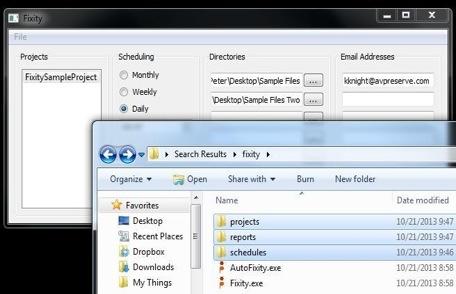 Fixity monitors file integrity through generation and validation of checksums, and file attendance through monitoring and reporting on new, missing, moved and renamed files.
Fixity monitors file integrity through generation and validation of checksums, and file attendance through monitoring and reporting on new, missing, moved and renamed files.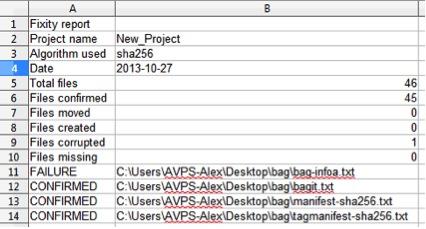 AVPreserve created Fixity after coming to the realization that:
AVPreserve created Fixity after coming to the realization that:
1. Checksum generation and validation are universally recognized as a primary mechanism for fulfilling the goal of fixity.
2. Generating checksums without systematically and routinely validating them is of little or no use.
3. Most organizations that “use checksums” only generate checksums but don’t validate them routinely, if at all.
4. The primary reason organizations don’t systematically and routinely verify checksums is because there is no tool that allows scheduling and reporting of validation.
5. Organizations that do routinely verify checksums do not typically monitor and report on file attendance types of information.
6. Overcoming the lack of resources and/or access to IT expertise is a critical factor in enabling organizations to fulfill the goal of fixity. Organizations need a simple, low cost tool.
There are many free and open source checksum utilities out on the market but they do not offer the feature set or simplicity necessary to fulfill the need that organizations have. Fixity was created with the sole focus of fulfilling the requirements of those concerned with monitoring fixity of a collection over the long term. It is intended for use in monitoring collections of files that are “final state”, or ready for deposit into an archive or preservation oriented repository.
MDQC stands for Metadata Quality Control. It is a free open source utility that reads the embedded metadata of a file or directory and compares it against a set of rules defined by the user.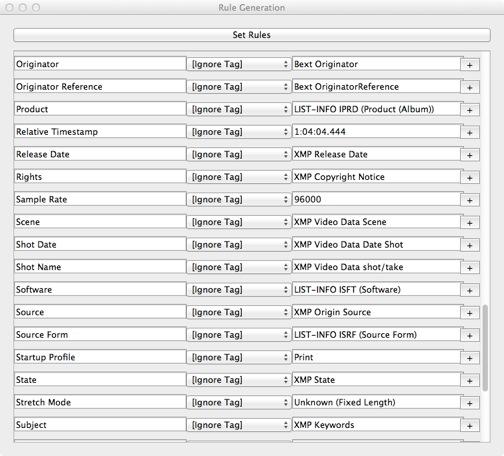 AVPreserve created MDQC after doing a great deal of wrangling data using a combination of scripts, ExifTool, MediaInfo, spreadsheets and formulas. The most common use to date has been to automate and minimize the time needed to QC large batches of digitized or reformatted assets. For instance, organizations have used MDQC on files being returned from a vendor or in-house lab to verify technical parameters, such as bit depth, sample rate, codec and aspect ratio, as well as non-technical parameters such as copyright statements, title information, identifiers and more.
AVPreserve created MDQC after doing a great deal of wrangling data using a combination of scripts, ExifTool, MediaInfo, spreadsheets and formulas. The most common use to date has been to automate and minimize the time needed to QC large batches of digitized or reformatted assets. For instance, organizations have used MDQC on files being returned from a vendor or in-house lab to verify technical parameters, such as bit depth, sample rate, codec and aspect ratio, as well as non-technical parameters such as copyright statements, title information, identifiers and more.
Although this has been the primary use so far MDQC can be used in any workflow where comparing actual metadata to expected metadata is useful. MDQC can be used on any file type supported by ExifTool and MediaInfo.
Direct downloads and User Guides of these (and other tools!) are available on our Tools page, or via the Fixity and MDQC GitHub pages.
Both of these applications are in beta. Please help refine them further by reporting all bugs to https://github.com/avpreserve/mdqc/issues or https://github.com/avpreserve/fixity/issues. User feedback is always welcome directed to info{@}avpreserve{dot}com.